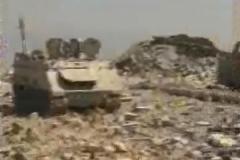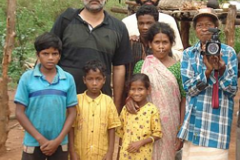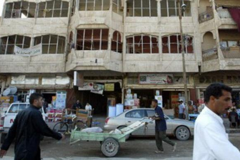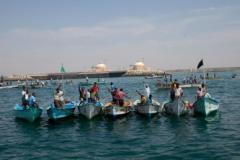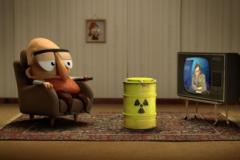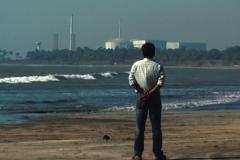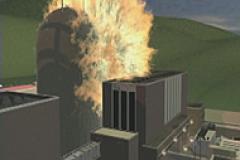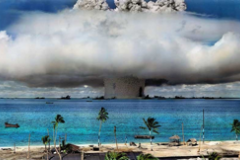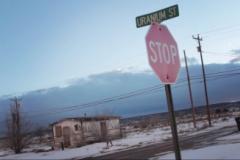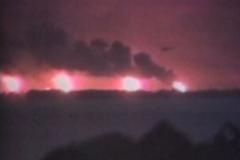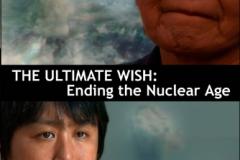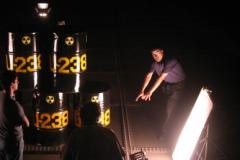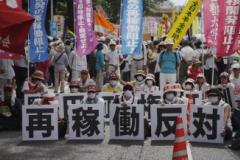MISSION IMPOSSIBLE II
Press Releases - Aug 25, 2014
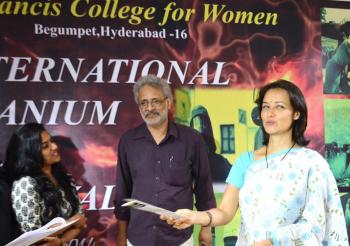 The Uranium Film Festival travelled for the 2nd time to India, a country with 1,2 billion people still looking for 24 hours electricity. India is still in need for cheap energy for millions of small housholds. Is nuclear power the solution? Is it save, clean and cheap? The festival travelled to 6 cities, reached over 4000 spectators. One said: “One of the signs of a good program is that you can't shake it off your thoughts even after leaving the function hall." Download Report
The Uranium Film Festival travelled for the 2nd time to India, a country with 1,2 billion people still looking for 24 hours electricity. India is still in need for cheap energy for millions of small housholds. Is nuclear power the solution? Is it save, clean and cheap? The festival travelled to 6 cities, reached over 4000 spectators. One said: “One of the signs of a good program is that you can't shake it off your thoughts even after leaving the function hall." Download Report
One of the 4000 spectators said: “One of the signs of a good program is that you can't shake it off your thoughts even after leaving the function hall. Today's program was one such. Thank you for organizing the Uranium Film Festival."
A debate about pro and cons of nuclear energy is at pick, especially if we recognize that he Fukushima nuclear meltdown is still far from being resolved. But what is a debate without proper information? In this crucial time the International Uranium Film Festival (IUFF) from Rio de Janeiro has come up with the unique collection of films which are telling true stories of the entire nuclear fuel chain. After 2013 the in the world unique film festival travelled now with its best and most interesting nuclear films a second time through India, “mission impossible II”.
This second edition of the traveling International Uranium Film Festival (IUFF) took place in six different cities throughout India between March and May 2014: Ahmedabad, Hyderabad, Manipal, Bangalore, Mumbai and Tatanagar und it reached a diverse audience of about 4,000 people, students, teachers, local population. Now the Uranium Film Festival organizers have published their official report about that amazing travel.
“The most moving and humbling moment of the festival was when a young student in Hyderabad shed tears and with a lump in her throat said, she felt betrayed by her upbringing and education which kept her in dark about dark issues as this. She said, till her participation in the festival she had no idea, not even remotely close, about such cruel and inhumane things happening in the world and shaking the world while she was breathing the same air in the very same world”, says the IUFF South-Asia Director and Award winning filmmaker Shri Prakash. “The future of Indian science participated in huge numbers in the panel discussion and the screenings and widened their horizon by seeing the links between science and its multiple impacts which some said were never discussed in the classroom. The atmosphere was overwhelming.”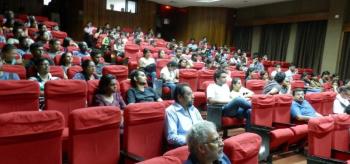 From Ahmedabad to Tatanager: The traveling Uranium Film Festival and its about 50 international films starting from uranium minig to nuclear waste attracted stimulated fruitful debates and not only scholars but also people from politics and showbusines like Actor turned activist Amala Akkineni from Hyderarbad. She opined that it is not miners but top authorities who as decision makers can stand against the evils of Uranium mining and bring change. In Mumbai eminent documentary filmmaker Anand Patwardhan said, he was immensely happy to see the film festival continue for the second year. Saying that he would love to see this travelling film festival be a regular event in India he expressed his solidarity with the festival.
From Ahmedabad to Tatanager: The traveling Uranium Film Festival and its about 50 international films starting from uranium minig to nuclear waste attracted stimulated fruitful debates and not only scholars but also people from politics and showbusines like Actor turned activist Amala Akkineni from Hyderarbad. She opined that it is not miners but top authorities who as decision makers can stand against the evils of Uranium mining and bring change. In Mumbai eminent documentary filmmaker Anand Patwardhan said, he was immensely happy to see the film festival continue for the second year. Saying that he would love to see this travelling film festival be a regular event in India he expressed his solidarity with the festival.
“We too would love to see the Uranium Film Festival to be a regular event in India”, answers the in Brazil living Uranium Film Festival´s general director Norbert G. Suchanek. He is very grateful that the Goverment of India for the second time gave allowance to this important festival that showcases films from all over the world tackling a delicate and highly controversial issue: The question of the use of nuclear power.
Suchanek: “In 2013 the festival visited 10 Indian cities from New Delhi in the North to Chennai in the South and the films reached a huge and cultural diverse audience. In 2014 our South-Asia director Shri Prakash brought the film festival to six cities. He had to do it alone this year, because we had also Uranium Film Festivals early this year in Washington DC and New York and we had to organize the huge Uranium Film Festival in Rio de Janeiro in May. We hope in 2015 with more funding we can return to India and meet the demand of more film festivals in more Indian cities.”
All together the IUFF 2014 reached in India over 4000 spectators. One of these was Ms. Amruta R. Eswara. She said: “One of the signs of a good program is that you can't shake it off your thoughts even after leaving the function hall. Today's program was one such. Thank you for organizing the International Uranium Film Festival in India."
Now in a few weeks the festival will continue to travel. Next destinations are the capitals of Germany (Berlin) in September and of Jordan (Amman) in December 2014.
Click to > Download here the Uranium Film Festival India Report 2014
Uranium Film Festival Office / Rua Monte Alegre. 356 / 301 - Rio de Janeiro / RJ - CEP 20240-194 - Brazil
Germany, 2012, 4 min, no dialogue
Animation
World Premiere
Animated short film about Fukushima children who can't play outside. About their dreams and realities.
Bachelor in 2012 of Shoko Hara and Paul Brenner
Sound design and Music: Lorenz Schimpf
Teachers: Prof. Klaus Birk, Alexander Hanowski, Martin Hesselmeier
DHBW Ravensburg, Studiengang Mediendesign
Director Paul Brenner present, Munich 2013
(Anatomia di una Bomba)
Directors: Angelo Saso and Maurizio Torrealta
Italy, 2006, 22 min, English
Production Rainews24
The Israeli army denied the use of uranium-based weapons in Lebanon. So, how can people defend themselves from potential uranium-related harm? What precautions will the Unifil troops in the area take, and what kind of testing has been carried out to prevent the risks? The documentary directly covers those questions.
(Atomny Ivan)
Russia, 2012, 91 min, Russian, English subtitles
Production: Telesto Film Company
Romantic Comedy
That is a plane story of people from the future which is getting to be real nowadays. The heroes are beautiful and helpless, but they continue to fight for their own happiness and purport. The story takes place in the town where the nuclear engineer may live in one apartment with his mother, the nuclear engineer and his grand-mother – the pioneer of nuclear industry. The story is really outstanding, it is about Ivan and Tania, Tania is interested in her science carrier and Ivan is not interested in anything, but Tania. The new third hero makes heroes to wake up. A lyrical comedy.
Producer Victoria Gromik present, Munich 2013
United Kingdom, 2010, 71 min, English
Directors and Producers: Meera Patel and Wolfgang Matt
Production: Maddmovies
Documentary
A story about the biggest weapons of mass destruction ever created, the people who use them and, more importantly, the people who fight them. 'Beating the Bomb' charts the history of the British peace movement against the backdrop of the atomic age. The film also frames the nuclear weapons issue within the wider context of global justice.Beating the Bomb, United Kingdom, 2010, 71 min.
www.beatingthebomb.com, contact: maddmovies@gmail.com
"Beating the Bomb" was selected by the Uranium Film Festival Jury as one of the eight best documentaries of the festival.
Best documentary award, Red Rock Film Festival, Utah, USA
(Ragi Kana Ko Bonga Buru)
India, 1999, 52 min, English
Documentary
Not part of the Competition
"Buddha Weeps in Jadugoda" is a documentary film on uranium mining and its deadly impacts on the tribal people living near the Jadugoda mine, mill and tailings dam, in the East Singhbhum district of Jharkhand (India). Unsafe mining, milling and tailings management by UCIL in this area for almost 30 years has resulted in excessive radiation, contamination of water, land and air, destruction of the local ecology, and lead for to genetic mutation, and slow death for the people of the region. The film attempts to depict the gross misuse of power by the authorities in displacing the original inhabitants of the region, the utter lack of concern for internationally accepted norms and safety precautions in the handling of uranium and its by-products, and their callousness of its disastrous impact on the people and the region.
Director Shri Prakash present, Berlin 2012
Q&A with Shriprakash + RAOUF DABBAS, Amman 2014
(Verstrahlt und vergessen, Tschernobyl und die Folgen)
Germany, 2006, 59 min, German/ Russian, English Subtitle
Production: ARTE – WDR
Brazilian Premiere
April 26th 1986. The day a nightmare scenario became horrific reality: the day reactor block 4 of the Chernobyl atomic power station exploded. While researching and filming this project filmmaker Christoph Boekel met numerous victims of the atomic catastrophe. His own wife was one them and she, too, died of cancer. A moving film told from the personal perspective of the director, it is a requiem for the often forgotten victims of the disaster and a caveat against putting blind trust in technological advancement.
(Irak: Les Enfants Sacrifiés De Falluja)
Irak/France | 2011 | 48 min | Documentary
Director: Feurat Alani | Producer: Baozi Production
Original Language: English and French
In 2004, Fallujah in Iraq became the theater of a major showdown between american army and iraq insurgents. But what the american used in this war is secret. What kind of weapons did they drop? For now and since 2005, deformed babies are born. What really happened in Fallujah? Is depleted uranium the cause of the health problem?
Film website: http://www.baoziprod.com/New/?p=3440
Director's Blog: http://feuratalani.blogspot.com.br
Awards:
Investigation award and Remand Center Award in Grand Scoop Festival in Lille, 2011
Freedom and human rights Award in Al Jazeera Festival in Qatar in April 2012
International Committee of the Red Cross Award in Monte-Carlo’s Festival in June 2012
Public Award and Jury Award in Khouribga Documentary Film Festival (Morocco), 2012
(Gere Dan)
India, 2014, 48 min, French/English with English subtitle
World premier in NewYork City
Niger, Gabon, Congo and other African countries had been going through the experience of Uranium mining since decades. But now more and more Uranium mining companies are going to Africa more aggressively. Poverty, lack of governance and political instability has made this area as heaven for these mining companies. This film is trying to looking from inside of a tiny village 'Falea' in Mali where drilling for prospecting of uranium is going on, and same time also try to see the multiple dimensions of the uranium mining and vested interests of world powers in that same sub-Sahara region.
Both filmmakers are present (New York 2014).
Japan, 2012, 57 min, Japanese, English subtitles
Documentary
World Premiere
It is a documentary on the aftermath of the disaster in Fukushima.
Someone said "Fukushima, it's like a parallel world". It's another world. Apparently, from the outside, everything looks normal. Outside the exclusion zone of 20km, life continues as before, but not quite, this is only an appearance. The danger is invisible. My challenge is: how to make visible what is invisible.
India, 2012, 34 min, Tamil/Malayalam with English Subtitles
Documentary
It is an answer to many of the myths surrounding the nuclear power projects, the world over. Though this film is set particularly in the back drop of the Kudankulam Nuclear Power Project and the people's struggle against it, it raises almost all of the questions regarding the safety of nuclear plants, development and its imposition on a people, alternate sources of energy and their contribution to the total energy needs, the lack of scientific know-how in disposing nuclear waste, the dependence on foreign resources in the running of a nuclear power plant anywhere in the Third World countries and the ups and downs of the People's Movement Against Nuclear Energy (PMANE), in Kudankulam, India.
(Herr Hoppe und der Atommüll)
Germany, 2011, 4 min
Producer Filmakademie Baden – Württemberg
Animation
A barrel of nuclear waste drops into the living room of Herr Hoppe an average suburbian German. He has to get rid of it and does it in his own wacky way.
India | 2013 | 27 min | Documentary
Director: Pradeep Indulkar
Original Languages: Marathi/English | Subtitles: English, German, French
Synopsis:Tarapur Nuclear Power Project is India's first civil nuclear establishment came in existance around 50 years ago, displacing few villages near town named Tarapur. Once a protagonist visits those villages Dandi, Pofaran, Ghivali, Unbhat and Tarapur after 40 long years. He observes the situation of thousands of displaced people. He finds that they lost their traditional jobs and they did not get any new jobs, they lost their lands, homes and sea and they didn't get proper compensation neither they got the promised services and infrastructures like roads, water, electricity, medical facilities, schools etc. etc. Instead they got illness and unknown deceases. The high blood pressure and heart attack cases increased. Kidney failure and miscarriages and still births and complicated delivery cases increased. The kids below 5 years are suffering by mental disorders. Their IQ is low. The real cost of power is paid by those unknown and innocent people.
Film Website: http://highpowerdoc.webs.com/apps/links/
Awards:
YELLOW OSCAR, Best Short Documentary, International Uranium Film Festival Rio 2013
USA, 2003, 29 min, English
Documentary
Latin American Premiere
Shows the impossibility of evacuation at Indian Point nuclear power plant outside NY City. Produced after the 9/11 terror attack on New York City and the terrorists announced they had targeted the Indian Point Nuclerar Power station but decided to fly by it to the Twin Towers instead.
Tobe Carey will attend the screening (New York, 2014).
USA | 2012 | 87 min | Documentary
Director: : Adam Jonas Horowitz
Original Language: Marshallese & English | Subtitles: French / Spanish
Featuring recently declassified U.S. government documents, survivor testimony, and unseen archival footage, Nuclear Savage uncovers one of the most troubling chapters in modern American history: how Marshall islanders, considered an uncivilized culture, were deliberately used as human guinea pigs to study the effects of nuclear fallout on human beings.
Between 1946 and 1958 the United States tested 67 nuclear weapons above ground on or near Bikini and Enewetok atolls. The hydrogen bomb was 1000 times more powerful than the Hiroshima bomb. Entire islands were vaporized and populated islands were blanketed with fallout. As the film shows, the heavily exposed people of Rongelap were then enrolled as human subjects in the top-secret Project 4.1 and evacuated to a severely contaminated island to study the effects of eating radioactive food for nearly 30 years. Many of the Marshall Islanders developed cancers and had babies that were stillborn or with serious birth defects.
Nuclear Savage follows the islanders today as they continue to fight for justice and acknowledgement of what was done to them. Despite recent disclosures, the U.S. government continues to deny that the islanders were deliberately used as human guinea pigs. The film raises disturbing questions about racism, the U.S. government’s moral obligation to the people of the Marshall Islands, and why the government is continuing to cover up the intent of the tests and Project 4.1 after several decades.
Awards:
AUDIENCE AWARD, Best Film Cinema Planeta International Festival, Mexico
JURY PRIZE, Best Feature Documentary, Paris/FIFE International Festival of Environmental Films
JURY PRIZE, Chicago Peace on Earth Film Festival
YELLOW OSCAR, Best Feature Documentary, International Uranium Film Festival Rio 2013
More information:
http://ncronline.org/blogs/eco-catholic/yellow-oscar-goes-documentary-ex...
http://www.veteranstoday.com/2014/01/24/americas-nuclear-radiation-cover...
http://www.globalresearch.ca/media-coverup-of-impacts-of-u-s-nuclear-wea...
USA, 2012, 12 min, English
Documentary
Just outside Grants, New Mexico, is a 200-acre heap of toxic uranium waste, known as tailings. After 30 years of failed cleanup, the waste has deeply contaminated the air and water near the former uranium capital of the world. TAILINGS is a cinematic investigation into the pile that is gravely shaping the lives of those who are stuck living in its shadow.
TRAILER: http://tailingsfilm.com
TAILINGS won the Best New Mexico Short Award of the Santa Fe Independent Film Festival.
Iran, 2013, 6 min, without dialog
Animated fiction
Special Achievement Award 2013
A world war had been destroyed the entire civilization. Everybody is wondering around lost, neglecting each other. Until one day a young girl finds the last flower on earth. Excited from her discovery she runs to people to tell them about the flower, but people do not care. At last a young man shows interest to the story. Together they take care of the flower and fall in love. With love, the entire planet grow and people begin to build civilization again. Meanwhile the war machine factories appear and the story of war begin again...
(La Terza Bomba Nucleare, Le Accuse del Veterano)
Italy, 2008, 26 min, English
Production: Rainews24 / Radio Televisione Italiana
Latin American Premiere
In the investigative report, an American veteran who participated in "Desert Storm" accuses the Us Administration of having used a small nuclear penetration bomb with an energy of 5 kilotons between the Iraqi town of Basra and the border with Iran. Consulting the "Seismological International Center on line data archive" we found that in the area indicated by the veteran, a seismic event with a power of 5 kilotons was registered the last day of the conflict.
Following discussion with the director, Munich 2013
USA, 2012,40 min, English/Japanese/French, English subtitles
Co-production Kathleen Sullivan
Documentary
Moving, unforgettable living witnesses who survived two of the world's most momentous radiation crises: Nagasaki in 1945 and Fukushima in 2011.
They are interlaced with nuclear experts and archival footage, some shocking, illuminating the largely unrecognized connection between nuclear weapons and nuclear power, and the growing global movements to abolish both.
The documentary is both a tragic and an inspirational example of courageous women in the face of environmental catastrophes and an alert to everyone today about the dangers of continued nuclear proliferation and nuclear power.
http://richtervideos.com/TheUltimateWish/
Director will be present (New York 2014)
(Uranio 238: La Bomba Sucia del Pentágono)
Costa Rica, 2009, 28 min, English, Spanish subtitles
Producer Isabel Macdonald and San José Quaker Peace Center
Documentary
Uranium 238 depicts the hazards that the use of depleted uranium or DU in conventional weapons poses for the health of soldiers and civilians. Through interviews with soldiers, scientists and activists, the documentary explores the health hazards when this radioactive and toxic material is ingested or inhaled by people in the battle fields and shooting ranges. Based in scientific data this video has been used by the International Coalition to Ban Uranium Weapons (ICBUW) as part of its international campaign to prohibit DU as a military component.
URANIUM 238 - The Pentagon´s Dirty Pool won the Jury Award as the Best Short Film of the First International Uranium Film Festival 2011.
(Uranium, l'héritage empoisonné)
France | 52 min | Documentary
Director: Dominique Hennequin | Producer: Nomades TV
Language: French and English
Synopsis: A shocking investigation into uranium mining in Africa. We visit three areas affected by the uranium industry; Mounana where activity has now ceased, Arlit, where the mines have been active for 40 years, and Imouraren, a future site. French energy giant Areva pulled out of Mounana, Gabon, in 1999. The uranium mine, Comuf, was closed down and covered over. In fact, at a glance, it’s almost as if the mine never existed. However, Mounana suffers from extremely dangerous levels of radioactive pollution. The soil and the rivers are toxic; even the houses have a Geiger count as much as 8 times the safe limit. They were built using radioactive material.
In Arlit, North Niger, we encounter similar problems, including an abnormally high incidence of lung cancer. Now that Areva has left, the former miners are left to pay for their own health care. In spite of the horrific damage to local populations at previous sites, another mine is being constructed, in Imouraren. The result of a colossal deal between the governments of France and Niger, this will be their biggest open mine yet. Areva claims that the new mine will not poison the land, but local people are sceptical.
Film website: http://www.javafilms.fr/spip.php?article311
Australia, 2010, 35 min, English
Documentary
The film combines comedy and serious content to explain the dangers of uranium mining, the nuclear fuel cycle and the use of depleted nuclear materials – much of which originates in Australian uranium mines – in weapons production. The message is simple and clear: Despite assurances from the mining companies, there is NO SAFE LEVEL of radiation exposure, below which there is no risk of cancer or birth defects occurring. "When The Dust Settles" is a must-see educational presentation for workers contemplating working in the uranium industry and for Electrical Trades Union members and workers across Queensland and the Northern Territory.
Japan, 2012, 27 min, English subtitles
Kugi Productions
Documentary
Six Japanese women offer brutally honest views on the state of the clean-up, the cover-ups and untruths since the nuclear accident in Fukushima, and how it has affected their lives, homes and families.


